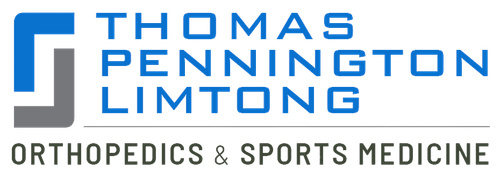What is Shoulder Impingement Syndrome (swimmer’s shoulder)?
 Shoulder impingement syndrome, commonly known as a swimmer’s shoulder or thrower’s shoulder occurs when the tendons of the rotator cuff become impinged as they pass through the shoulder joint. The condition may occur gradually through overuse or follow a partial tear of a rotator cuff tendon.
Shoulder impingement syndrome, commonly known as a swimmer’s shoulder or thrower’s shoulder occurs when the tendons of the rotator cuff become impinged as they pass through the shoulder joint. The condition may occur gradually through overuse or follow a partial tear of a rotator cuff tendon.
Board certified orthopedic surgeons at Thomas & Bigler Knee & Shoulder Institute provide treatments for shoulder impingement syndrome to patients in Las Vegas, Nevada, and other cities and towns in The Silver State.
Symptoms
Symptoms of this condition may include pain which develops over a period of time. There will be pain at the front and side of the shoulder joint, particularly when the patient makes overhead movements such as in throwing, racket sports and swimming.
When the arm is held out to the side turned outwards, the patient may experience pain in the shoulder. If the pain occurs in arc from about 70 degrees to 130 degrees when the patient raises the arm out sideways and up above the shoulder, it is another sign of shoulder impingement.
Causes
Shoulder impingement syndrome is caused by the rotator cuff tendons becoming impinged as they pass through the subacromial space. With repetitive pinching, the tendons become irritated and inflamed. This can result in thickening of the tendon, which may lead to additional problems because there is very little free space.
As the tendons become bigger, they are further impinged due to the shoulder joint structures and the muscles themselves. There are various different causes of shoulder impingement syndrome which include bone spurs, rotator cuff injury, labral injury, shoulder instability, biceps tendinopathy and scapula dysfunction.
The condition can develop into a rotator cuff tear if left untreated. The muscle most commonly involved in this syndrome is the
supraspinatus. Shoulder impingement will be categorized as internal or external on the basis of its cause. External impingement is divided into primary impingement, which is caused by a bony spur, and secondary impingement, which occurs due to poor stabilization of the shoulder joint.
Treatment
Shoulder impingement treatment is based on the goals of mitigating pain and inflammation, improving mobility and strength while diagnosing and addressing the possible causes to ensure it does not recur. As a first step, the patient should apply the PRICE principles of protection, rest, ice, compression and elevation.
The shoulder should be rested from any painful activities or movements. The patient must apply ice therapy and compression wrap to the painful area for about 15 minutes per hour initially. As the symptoms reduce, the frequency of therapy should be reduced to three to four times a day.
Anti-inflammatory medications may be prescribed to reduce pain and inflammation. A professional therapist may use electrotherapy such as ultrasound as well as recommend a customized rehabilitation and exercise program. Steroid injections into the subacromial space to reduce inflammation may be used in exceptional cases.
Steroids are not an early option and are typically recommended after a period of at least six to 12 months of therapy. Remarkable, perspicacious, and board certified orthopedic surgeons Dr. Steven Thomas and Dr. Gregory Bigler provide shoulder impingement syndrome treatments to patients in Las Vegas, Nevada and other towns and cities in this part of the southwest.
If you would like to schedule an appointment or learn more about the Knee and Shoulder Institute procedures & treatments performed by Las Vegas, Nevada board certified surgeons Steven C. Thomas, MD and Gregory T. Bigler, MD. call (702) 933-9393; Physical Therapy (702) 933-9393.
